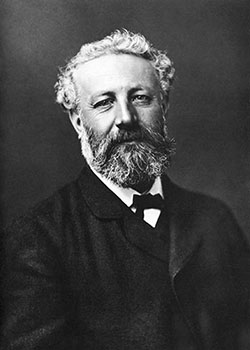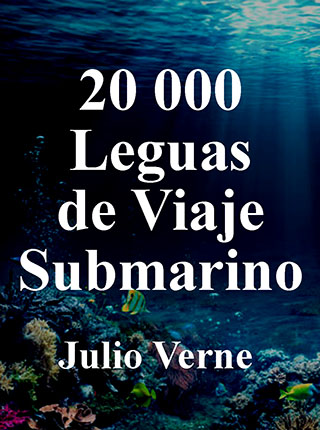Description: La novela “20 000 Lenguas de Viaje Submarino” es la gran aventura maritima que el escritor frances Julio Verne había escrito. En estas paginas podras abordar “Nautilus” y junto al capitan Nemo viajar por todo los mares del mundo. En este maravilloso recorrido seras testigo del monstruo que mantenia amedrentadas a las demas embarcaciones; conoceras el extrano bosque submarino y la isla de los salvajes; y muchisimas cosas mas.
Es una obra narrada en primera persona por el profesor francés Pierre Aronnax, notable biólogo que es hecho prisionero por el Capitán Nemo y es conducido por los océanos a bordo del submarino “Nautilus”, en compañía de su criado Conseil y el arponero canadiense Ned Land.
La historia comienza con una expedición a bordo de un buque de la marina de guerra estadounidense: el Abraham Lincoln, al mando del almirante Farragut, que busca dar caza a un extraño cetáceo, con un largo y filoso cuerno en el hocico (luego se demuestra que el animal es un narval), que había ocasionado daños a diversas embarcaciones. Durante la expedición, los protagonistas se ven lanzados por la borda del buque como resultado de una embestida del animal.
El profesor Aronnax y su acompañante Conseil son rescatados por el arponero canadiense Ned Land que también cayo al agua con ellos, después del impacto de la criatura, y los tres logran llegar a nado a un lugar seguro. Una vez a salvo, descubren que no se encuentran realmente en una isla, sino sobre una estructura metálica: un submarino a flote a cuyo interior acceden por una compuerta, llevados por ocho enmascarados.
En el interior del misterioso artefacto conocen al Capitán Nemo, personaje desgraciado y brillante, con un oscuro pasado y de grandes aptitudes científicas y artísticas. Éste les muestra toda la nave, “Nautilus”, y les da notables explicaciones sobre su ingeniería. El capitán les informa de que, al haber conocido su existencia, no puede dejarlos volver a la superficie.
A lo largo del viaje, les son revelados muchos secretos, y recorren diversos lugares, entre los que se menciona la mítica Atlántida, las islas de la Polinesia, el Mar Rojo, las costas del Lejano Oriente, el Mediterráneo, etc. A través de su personaje Aronnax, Julio Verne señala varios posibles inventos: escafandras autónomas de buceo, fusiles de balas eléctricas, máquinas para producir aire respirable, etc. Un rasgo que hace muy interesante a la novela es la minuciosa descripción de los paisajes submarinos que se visitan, así como la casi enciclopédica descripción de una infinidad de seres marinos.
Se da asimismo una minuciosa descripción de las percepciones y las intenciones de los personajes a lo largo de la historia. Queda claro, por ejemplo, que el arponero Ned Land es partidario de escapar. Tras una larga derrota y tras varios acontecimientos relativos a la vida a bordo del “Nautilus”, en el transcurso de los cuales éste es perseguido y atacado varias veces por buques de guerra, el capitán Nemo, presa de una fuerte depresión, se aísla de sus “invitados”.
The novel “20 Thousand Leagues of Submarine Travel” is the great maritime adventure that the French writer Jules Verne had written. In these pages you will be able to board “Nautilus” and together with Captain Nemo travel all over the seas of the world. In this wonderful journey you will witness the monster that kept the other boats scared; you will know the strange underwater forest and the island of the savages; and many more things.
It is a tale narrated in the first person by the French professor Pierre Aronnax, a notable biologist who is taken prisoner by Captain Nemo and is led through the oceans aboard the submarine “Nautilus”, in the company of his servant Conseil and the Canadian harpooner Ned Land.
The story begins with an expedition aboard a US Navy ship: the Abraham Lincoln, commanded by Admiral Farragut, who seeks to hunt down a strange cetacean with a long, sharp horn on its snout (later it is shown that the animal is a narwhal), which had caused damage to various boats. During the expedition, the protagonists are thrown overboard as a result of a charge from the animal.
Professor Aronnax and his companion Conseil are rescued by Canadian harpooner Ned Land who also fell into the water with them, after the creature’s impact, and the three manage to swim to safety. Once safe, they discover that they are not really on an island, but on a metallic structure: a floating submarine whose interior they enter through a hatch, carried by eight masked men.
Inside the mysterious artifact they meet Captain Nemo, a brilliant and unfortunate character with a dark past and great scientific and artistic skills. He shows them the entire ship, “Nautilus”, and gives them remarkable explanations about its engineering. The captain informs them that, having known of his existence, he cannot let them return to the surface. Throughout the journey, many secrets are revealed to them, and they travel through various places, including the mythical Atlantis, the Polynesian islands, the Red Sea, the coasts of the Far East, the Mediterranean, etc.
Through his character Aronnax, Jules Verne points out several possible inventions: autonomous diving suits, electric bullet guns, machines to produce breathable air, etc. A feature that makes the novel very interesting is the detailed description of the underwater landscapes that are visited, as well as the almost encyclopedic description of an infinity of marine beings. A detailed description of the perceptions and intentions of the characters throughout the story is also given. It is clear, for example, that the harpooner Ned Land is in favor of escaping. After a long defeat and after several events related to life on board “Nautilus”, during which it is pursued and attacked several times by warships, Captain Nemo, seized by severe depression, isolates himself from his “invited”.

Author: Julio Verne – Jules Verne
Jules Gabriel Verne, conocido en los países hispanohablantes como Julio Verne (1828-1905), fue un escritor, dramaturgo y poeta francés célebre por sus novelas de aventuras y por su profunda influencia en el género literario de la ciencia ficción.
Muy joven decidió para dedicarse a la literatura. Su colaboración con el editor Pierre-Jules Hetzel dio como fruto la creación de “Viajes extraordinarios”, una popular serie de novelas de aventuras entre las que se incluían las famosas “Cinco semanas en globo” (1863), “Viaje al centro de la tierra” (1864), “De la Tierra a la Luna” (1865), “Veinte mil leguas de viaje submarino” (1870), “La vuelta al mundo en ochenta días” (1872), “La isla misteriosa” (1874).
Es uno de los escritores más importantes de Francia y de toda Europa gracias a la evidente influencia de sus libros en la literatura vanguardista y el surrealismo. Se le considera uno de los “padres de la ciencia ficción”. Fue condecorado con la Legión de Honor en 1892 por sus aportes a la educación y a la ciencia.
Jules Gabriel Verne (1828-1905), was a French writer, playwright and poet famous for his adventure novels and for his profound influence on the literary genre of science fiction.
At a very young age, he decided to devote himself to literature. His collaboration with the publisher Pierre-Jules Hetzel resulted in the creation of “Extraordinary Voyages”, a popular series of adventure novels, including the famous “Five Weeks in a Balloon” (1863), “Journey to the Center of the Earth” (1864), “From the Earth to the Moon” (1865), “Twenty Thousand Leagues Under the Sea” (1870), “Around the World in Eighty Days” (1872), “The Mysterious Island” (1874).
He is one of the most important writers in France and in all of Europe thanks to the obvious influence of his books on avant-garde literature and surrealism. He is considered one of the “fathers of science fiction”. He was awarded with the Legion of Honor in 1892 for his contributions to education and science.
Language: Spanish
Year of edition: 1869
Pages: 480
This book is available in digital format only. You will receive the book file to your email after transferring the payment

